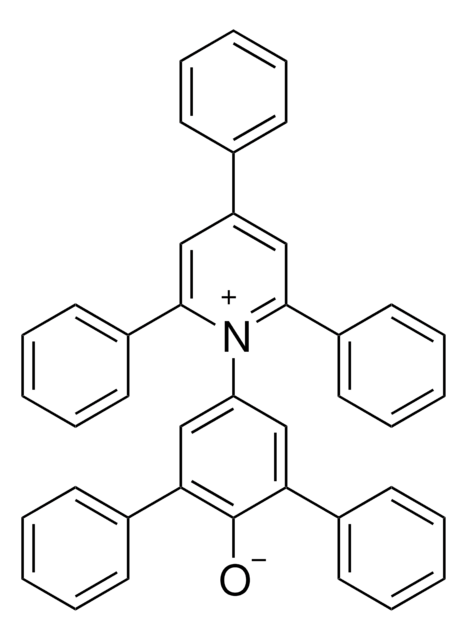Dye solar cells degrade from ultraviolet radiation. For this reason, the barrier may include UV stabilizers and/or UV absorbing luminescent chromophores (which emit at longer wavelengths) and antioxidants to protect and improve the effieciency of the cell.
703168
cis-Bis(isothiocyanato)(2,2′-bipyridyl-4,4′-dicarboxylato)(4,4′-di-nonyl-2′-bipyridyl)ruthenium(II)
95% (NMR)
Synonyme(s) :
Greatcell Solar®, Z-907 dye
About This Item
Produits recommandés
Essai
95% (NMR)
Forme
powder
Composition
Dye content, ≥90%
Pf
196 °C
λmax
531, 314, 295 nm (lit.)
Chaîne SMILES
S=C=N[Ru]N=C=S.OC(=O)c1ccnc(c1)-c2cc(ccn2)C(O)=O.CCCCCCCCCc3ccnc(c3)-c4cc(CCCCCCCCC)ccn4
InChI
1S/C28H44N2.C12H8N2O4.2CNS.Ru/c1-3-5-7-9-11-13-15-17-25-19-21-29-27(23-25)28-24-26(20-22-30-28)18-16-14-12-10-8-6-4-2;15-11(16)7-1-3-13-9(5-7)10-6-8(12(17)18)2-4-14-10;2*2-1-3;/h19-24H,3-18H2,1-2H3;1-6H,(H,15,16)(H,17,18);;;/q;;2*-1;+2
Clé InChI
LALSZYPVVQFXIC-UHFFFAOYSA-N
Catégories apparentées
Application
Informations légales
Greatcell Solar is a registered trademark of Greatcell Solar Materials Pty Ltd.
Mention d'avertissement
Warning
Mentions de danger
Conseils de prudence
Classification des risques
Eye Irrit. 2 - Skin Irrit. 2 - Skin Sens. 1 - STOT SE 3
Organes cibles
Respiratory system
Code de la classe de stockage
11 - Combustible Solids
Classe de danger pour l'eau (WGK)
WGK 3
Point d'éclair (°F)
Not applicable
Point d'éclair (°C)
Not applicable
Équipement de protection individuelle
dust mask type N95 (US), Eyeshields, Faceshields, Gloves
Faites votre choix parmi les versions les plus récentes :
Déjà en possession de ce produit ?
Retrouvez la documentation relative aux produits que vous avez récemment achetés dans la Bibliothèque de documents.
Les clients ont également consulté
Articles
Dye-sensitized solar cells directly convert sunlight to electricity
Operation principle and market dominance of single crystalline silicon solar cells.
Dye-sensitized solar cells (DSCs) are 3rd generation solar cells combining the promise of high efficiency with low production costs.
Organic materials in optoelectronic devices like LEDs and solar cells are of significant academic and commercial interest.
-
What can cause degradation of the dye solar cell?
1 réponse-
Utile ?
-
-
What is the Department of Transportation shipping information for this product?
1 réponse-
Transportation information can be found in Section 14 of the product's (M)SDS.To access the shipping information for this material, use the link on the product detail page for the product.
Utile ?
-
-
What are the advantages of dye solar cells?
1 réponse-
Dye solar cells (DSCs) are 3rd generation solar cells with the promise of high efficiency combined with low production costs.
Utile ?
-
-
What are the disadvantages of dye solar cells?
1 réponse-
The major disadvantage to the dye solar cell design is the use of a liquid electrolyte, which has temperature stability issues. The electrolyte can freeze at low temperatures and expand at higher temperatures. It the electrolytes freezes, power production would cease, and it could potentially lead to physical damage. If the liquid expands at higher temperatures, sealing the panels would be difficult.
Utile ?
-
Filtres actifs
Notre équipe de scientifiques dispose d'une expérience dans tous les secteurs de la recherche, notamment en sciences de la vie, science des matériaux, synthèse chimique, chromatographie, analyse et dans de nombreux autres domaines..
Contacter notre Service technique





2 ≥95%](/deepweb/assets/sigmaaldrich/product/structures/190/371/c5efe61d-383f-4364-90c6-1912d88674f3/640/c5efe61d-383f-4364-90c6-1912d88674f3.png)









